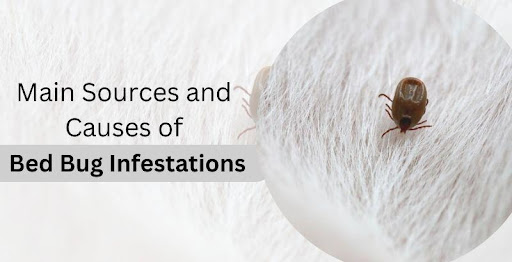General
Behind Closed Doors: Main Sources and Causes of Bed Bug Infestations

Bed bug infestations have become a widespread and growing concern, affecting homes, hotels, and other public spaces. To tackle this issue, we need to understand the sources and causes of these infestations.
In this post, we’ll uncover the major sources and causes of bed bug problems, revealing the hidden factors behind their relentless spread. Additionally, we will also discuss preventive measures and treatment, such as using sprays or setting up bed bug monitor traps. So, let’s dive in and shed some light on these bothersome pests!
Understanding Bed Bugs
Before we dive into the sources and causes of bed bug infestations, let’s get to know these pesky creatures. Bed bugs are small, reddish-brown insects that survive by feeding on the blood of humans and animals. They are mainly active at night and hide in mattresses, furniture, and cracks during the day, making spotting them challenging. You can identify a bed bug infestation through itchy bites, bloodstains on sheets, and dark spots (fecal matter) on bedding.
Main Sources of Bed Bug Infestation
Travel-related infestations
Hotels are common hotspots for bed bug infestations. When travelers unknowingly bring bed bugs with them, these pests can easily spread from room to room, infesting luggage, bedding, and furniture. Similarly, vacation rentals and accommodations offered through platforms like Airbnb can also harbor bed bugs if proper precautions are not taken by hosts and guests.
Used furniture and clothing
Imagine finding more than a good deal at a second-hand store or garage sale. Unfortunately, sometimes, these places unknowingly sell furniture and clothing that are infested with bed bugs. These pests can hide in the upholstery, mattresses, and seams of these pre-loved items. That’s why it’s crucial to carefully inspect and treat any second-hand purchases before bringing them into your home.
Public transportation and shared spaces
Bed bugs are excellent hitchhikers and can be inadvertently carried from one place to another through public transportation systems like buses, trains, and airplanes. Moreover, places like libraries, movie theaters, and offices where people spend considerable time offer ideal breeding grounds for these unwanted pests. So, it’s important to be aware of their ability to move around and use effective bed bug pest control methods to prevent their spread.
Causes of Bed Bug Infestations
Lack of awareness and prevention measures
Many people have limited knowledge about bed bugs, which hampers their ability to prevent infestations. Neglecting basic hygiene and cleanliness practices, such as regular cleaning and vacuuming, can create an inviting environment for bed bugs to thrive.
Poor Building Hygiene and Sanitation
Buildings with structural issues such as cracks, gaps, or damaged walls provide hiding places and entry points for bed bugs. Inadequate building maintenance can facilitate the movement and infestation of bed bugs within a structure.
Lack of Early Detection and Reporting
Delayed detection and reporting of bed bug infestations can allow them to spread further. If individuals fail to recognize the early signs of bed bugs or hesitate to report the issue, the infestation can worsen and impact more areas.
Responding to Bed Bug Infestations
Dealing with a bed bug infestation can be challenging, but taking prompt action is crucial. Here are the steps you can follow:
Confirm the infestation
Ensure you are dealing with bed bugs by thoroughly examining your bed frame, mattress, and visible areas in your bedroom. Look for live bugs, eggs, and rusty stains. You can also use bed bug monitor traps under the bed legs to capture and confirm the presence of bed bugs.
Isolate the Affected Area
Bed bugs can easily move to different parts of your home, so it’s crucial to keep the infested area and furniture separate. Don’t move infested items to other rooms; ensure new items don’t enter the isolated area.
Set up Monitor and Sticky Traps
Place glue traps on the mattress and floor and bed bug monitor traps under the bed legs. These traps will help eliminate bed bugs and monitor the progress of your efforts. To maximize the effects of these traps, try using multiple traps in the infected room.
Use Diatomaceous Earth Powder
DE is a natural substance that consists of fossilized remains of diatoms. When sprinkled in infested areas using a powder duster applicator, it acts as a desiccant, dehydrating and killing bed bugs.
Add protection
Once the infestation is resolved and the interceptor and sticky traps remain empty, consider adding mattress encasement to your mattress and pillows. These specialized covers will prevent bed bugs from accessing your sleeping area, ensuring a peaceful night’s sleep.
Final Words
Being aware of the sources and causes of bed bug infestations is vital for prevention and control. Whether they come from travel, used items, or shared spaces, understanding these factors helps us take necessary precautions. By promptly confirming infestations and opting for safe treatments, we can combat bed bugs effectively.
-
Blog1 year ago
MyCSULB: Login to CSULB Student and Employee Portal – MyCSULB 2023
-
Android App3 years ago
Cqatest App What is It
-
Android1 year ago
What Is content://com.android.browser.home/ All About in 2023? Set Up content com android browser home
-
Software2 years ago
A Guide For Better Cybersecurity & Data Protection For Your Devices
-
Latest News2 years ago
Soap2day Similar Sites And Alternatives To Watch Free Movies
-
Android2 years ago
What is OMACP And How To Remove It? Easy Guide OMACP 2022
-
Android3 years ago
What is org.codeaurora.snapcam?
-
Business2 years ago
Know Your Business (KYB) Process – Critical Component For Partnerships





















